Sugar skull tattoos have become increasingly popular in recent years, captivating both tattoo enthusiasts and those interested in the rich symbolism of these intricate designs. From their vibrant colors to their detailed patterns, sugar skull tattoos boast a unique allure that goes beyond mere aesthetics. In this article with Impeccable Nest, we delve into the fascinating world of sugar skull tattoos, exploring their meaning, symbolism, and design intricacies. So, if you’re curious about the deeper meaning of sugar skull tattoos, read on to uncover the hidden stories behind these captivating works of art.
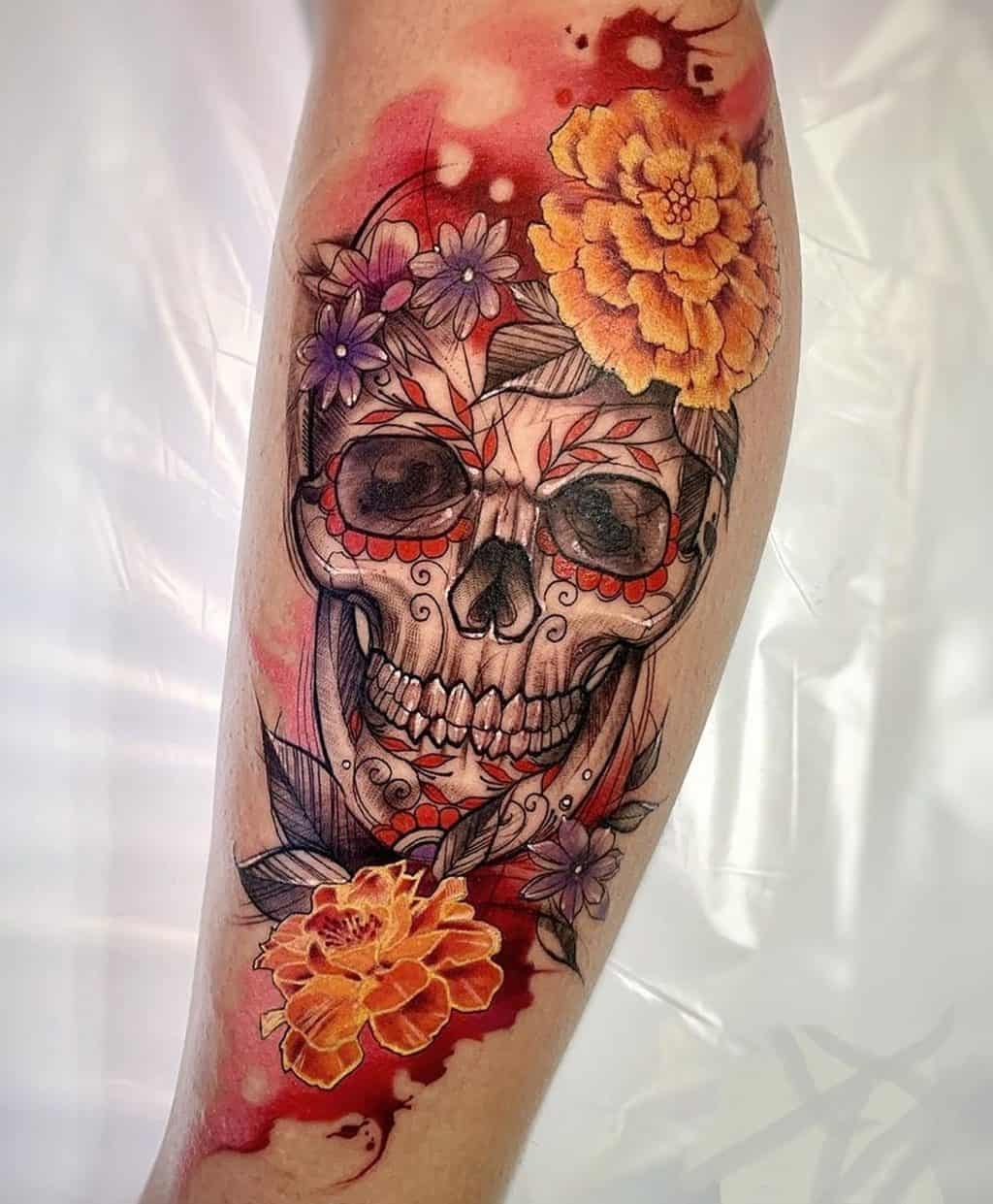
The Origins and Cultural Significance of Sugar Skulls
Sugar skulls have a rich and fascinating history deeply rooted in Mexican culture, particularly associated with the celebration of Día de los Muertos, or the Day of the Dead. These intricately designed skulls are an iconic symbol of this vibrant holiday and hold significant cultural and spiritual meaning.
The origins of sugar skulls can be traced back to pre-Columbian times when the Aztecs and other Mesoamerican civilizations used to honor their deceased ancestors. The Aztecs believed that death was merely a continuation of life, and they celebrated the lives of their departed loved ones rather than mourning their loss. They viewed death as a natural part of the human cycle, and Día de los Muertos became an occasion to remember and pay tribute to those who had passed away.
When the Spanish conquistadors arrived in Mexico in the 16th century, they brought with them Catholicism and All Saints’ Day, which falls on November 1st. Over time, these traditions merged with the indigenous practices, giving birth to the unique blend of customs that make up Día de los Muertos today.
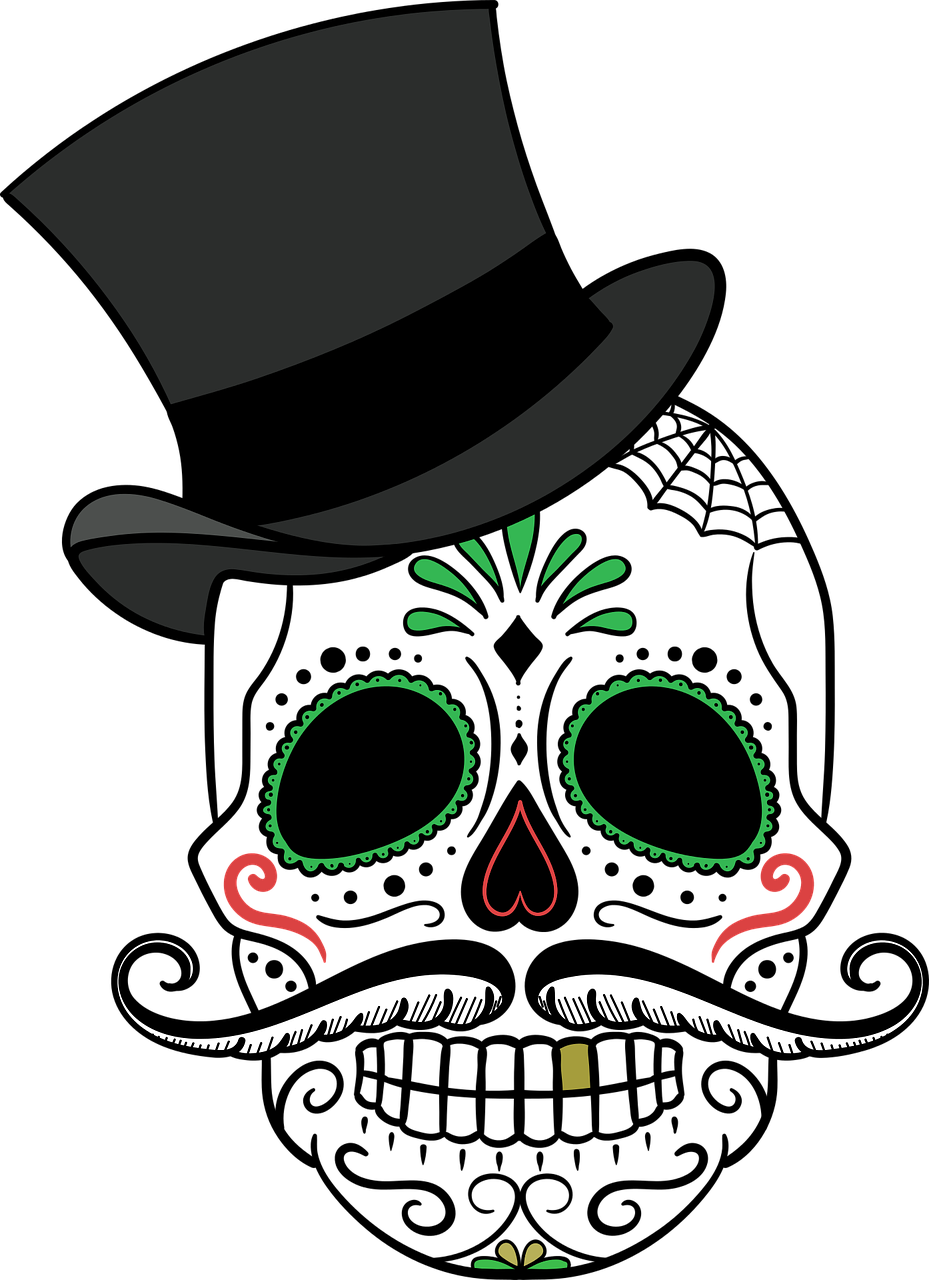
Sugar skulls gained prominence during this fusion of cultures. Originally made from amaranth dough, which held religious significance for the Aztecs, they later transitioned to sugar due to its abundance in the region. These skull-shaped confections were intricately decorated with colored icing, beads, and foil to resemble traditional calaveras (skulls). The symbolism of the skulls is two-fold; they serve as both a reminder of the inevitability of death and a playful representation of the deceased.
During Día de los Muertos, families set up elaborate altars known as ofrendas in their homes and gravesites to welcome the spirits of their loved ones. Sugar skulls are a prominent feature on these altars, often bearing the names of the departed individuals they represent. They are meant to guide the souls back to the world of the living during the festivities.
Sugar skulls have also gained widespread recognition outside of Mexico, becoming popular symbols associated with Día de los Muertos around the world. They have seeped into mainstream culture, appearing in various forms such as tattoos, fashion, and artwork. While this global appreciation is a testament to their aesthetic allure, it is crucial to remember and respect the cultural significance of these symbols.
Sugar Skull Tattoo Meaning: Unveiling the Spiritual Significance
When it comes to understanding the symbolisms associated with sugar skull tattoos, it’s crucial to appreciate their origins within Mexican culture and the Day of the Dead celebrations. Let’s explore some of the key meanings of sugar skull tattoos:
Celebrating Life and Death
The sugar skull tattoo holds a deep and meaningful significance, as it is rooted in the rich cultural tradition of Mexico’s Day of the Dead (Dia de los Muertos). This vibrant celebration takes place annually, typically on November 1st and 2nd, to commemorate and honor deceased loved ones.
The sugar skull itself is an essential symbol of Dia de los Muertos. It is intricately designed with colorful decorations, often featuring intricate patterns, flowers, and other elements. The purpose of these embellishments is to reflect the festive spirit of the occasion, emphasizing the joy and happiness associated with remembering those who have passed away.
When people choose to ink themselves with sugar skull tattoos, they are embracing the essence of life while paying homage to their departed family members and friends. These tattoos serve as a personal and permanent reminder of the enduring bond and love shared with the deceased.
Additionally, sugar skull tattoos symbolize the acceptance of mortality and the cycle of life and death. They represent a profound understanding that death is an integral part of existence and that celebrating the memories of our loved ones can bring solace and healing.
While sugar skull tattoos are closely tied to Mexican culture, they have transcended borders and gained popularity worldwide. Many individuals, regardless of their cultural background, get these tattoos as a way to honor their own departed loved ones or simply appreciate the beauty and symbolism of the design.
Honoring Ancestors and Loved Ones
Skull tattoos, particularly in the form of sugar skulls, hold significant cultural and symbolic value. They are often seen as an act of honoring and remembering ancestors and beloved individuals who have passed away. The sugar skull, which originated from the Mexican holiday Day of the Dead (Día de los Muertos), represents a celebration of life and the belief that death is not the end but rather a continuation of existence in another realm.
By choosing to wear a sugar skull tattoo, one can embody the spirit of this tradition and pay homage to the souls of those who have played pivotal roles in shaping their lives. The tattoo serves as a visual reminder of the departed and keeps their memory alive in a striking and meaningful manner.
Each sugar skull tattoo can be customized with various elements, such as ornate designs, flowers, or personal symbols, further adding to its significance. These embellishments often carry their own symbolic meanings, allowing the individual to incorporate personal narratives into the tattoo. For example, flowers like marigolds, commonly used in Day of the Dead celebrations, symbolize the fragility of life and can represent the ephemeral nature of human existence.
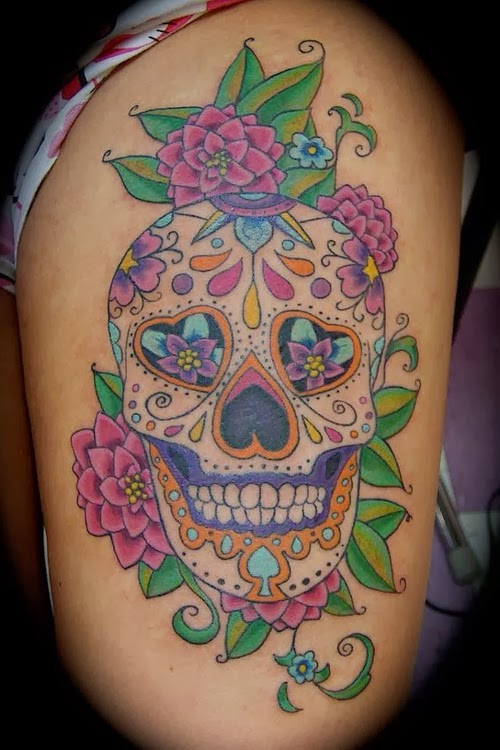
Skull tattoos also serve as a powerful reminder of mortality and the transient nature of life. They can evoke contemplation about the brevity of our time on Earth and encourage us to live fully, appreciating each moment and cherishing our connections with others. By donning a skull tattoo, individuals express their willingness to confront the reality of death while embracing the beauty and memories associated with those who have departed.
Embracing Transformation and Rebirth
The sugar skull, or calavera, is a key element in Day of the Dead (Dia de los Muertos) celebrations. This holiday, celebrated primarily in Mexico but also observed in other Latin American countries, honors deceased loved ones and serves as a reminder of the cycle of life and death. Sugar skulls are intricately designed and decorated with colorful patterns, flowers, and various symbols that represent life, death, and rebirth.
When individuals choose to adorn themselves with sugar skull tattoos, they are embracing the concept of transformation and acknowledging the beauty found within life’s constant evolution. These tattoos serve as a reminder to embrace change and recognize the impermanence of existence. They encourage wearers to appreciate the present moment and live life to the fullest, as well as celebrate the memories and experiences of those who have passed away.
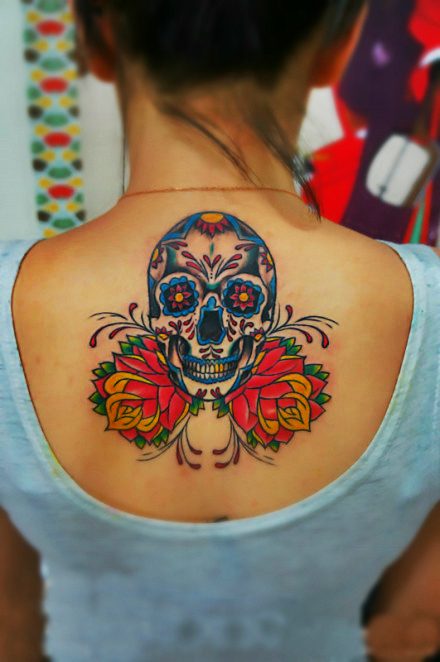
Moreover, sugar skull tattoos can also symbolize honoring and remembering loved ones who have departed. By incorporating personal elements such as names, dates, or specific designs into the tattoo, individuals can pay tribute to their loved ones’ lives and keep their memories alive. This not only serves as a form of remembrance but also represents a continuation of the bond shared with those who have transitioned into the spiritual realm.
Furthermore, sugar skull tattoos exemplify the fusion of life and death, showcasing the notion that both are intertwined and should be embraced rather than feared. The intricate and lively designs of sugar skulls juxtapose the traditional associations with death, transforming them into vibrant symbols of celebration. These tattoos empower individuals to face their mortality with courage and grace, finding beauty in the inevitable passage of time.
Representing Protection and Guidance
One of the primary meanings associated with sugar skull tattoos is the commemoration and celebration of deceased loved ones. In Mexican culture, Día de los Muertos is a time to honor and remember those who have passed away. Sugar skulls, or calaveras, are an integral part of this tradition. By getting a sugar skull tattoo, individuals pay tribute to their ancestors and maintain a connection with their heritage.
Moreover, sugar skull tattoos can be seen as a symbolic representation of life and death. The skull itself is often considered a potent symbol of mortality and the impermanence of human existence. However, the addition of vibrant colors and decorative elements on the sugar skull signifies the celebration of life and the belief in the continuity of the spirit beyond death. This combination of dark and bright imagery reflects the cycle of life, reminding us that death is merely a part of the natural progression.
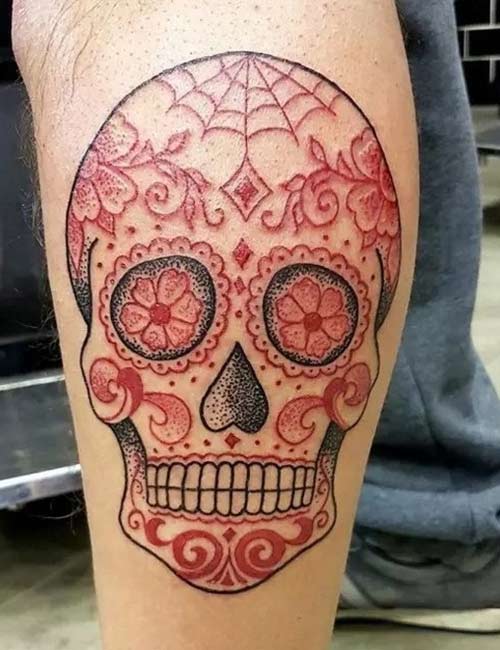
Furthermore, sugar skull tattoos can also serve as a means of seeking guidance and protection from ancestral spirits or supernatural forces. In many cultures, including Mexican folklore, it is believed that the souls of the departed remain connected to the living world and can offer assistance and protection. By having a sugar skull tattoo, individuals may feel a sense of spiritual security and connection to their ancestors. They see it as a powerful talisman that wards off negative energy and brings good fortune.
The intricate details and designs of sugar skull tattoos allow for individual interpretation and personalization. Each tattoo can be unique, reflecting specific aspects of the person’s life, beliefs, or experiences. Some people choose to incorporate names or dates of loved ones within the design, further emphasizing the personal connection and remembrance.
Reflecting Individual Identity and Creativity
These tattoos serve as a representation of honoring and remembering loved ones who have passed away. The sugar skull itself is a vibrant and intricately designed skull adorned with decorative elements such as flowers, hearts, and intricate patterns.
The main significance of sugar skull tattoos lies in their association with the Day of the Dead, which is a time when people gather to celebrate and remember their deceased family members and friends. This annual tradition is marked by vibrant festivities filled with colorful decorations, music, food, and joyful remembrance. Sugar skulls are an integral part of this celebration, representing the souls of departed loved ones returning to visit the living.
Beyond their cultural roots, sugar skull tattoos also offer individuals a powerful means of self-expression and creativity. Each design can be personalized to reflect the wearer’s unique identity, preferences, and personal experiences. Some people choose to incorporate meaningful symbols or elements that represent specific individuals they want to commemorate. For example, names, dates, or personal items may be included in the design to honor a loved one’s memory.
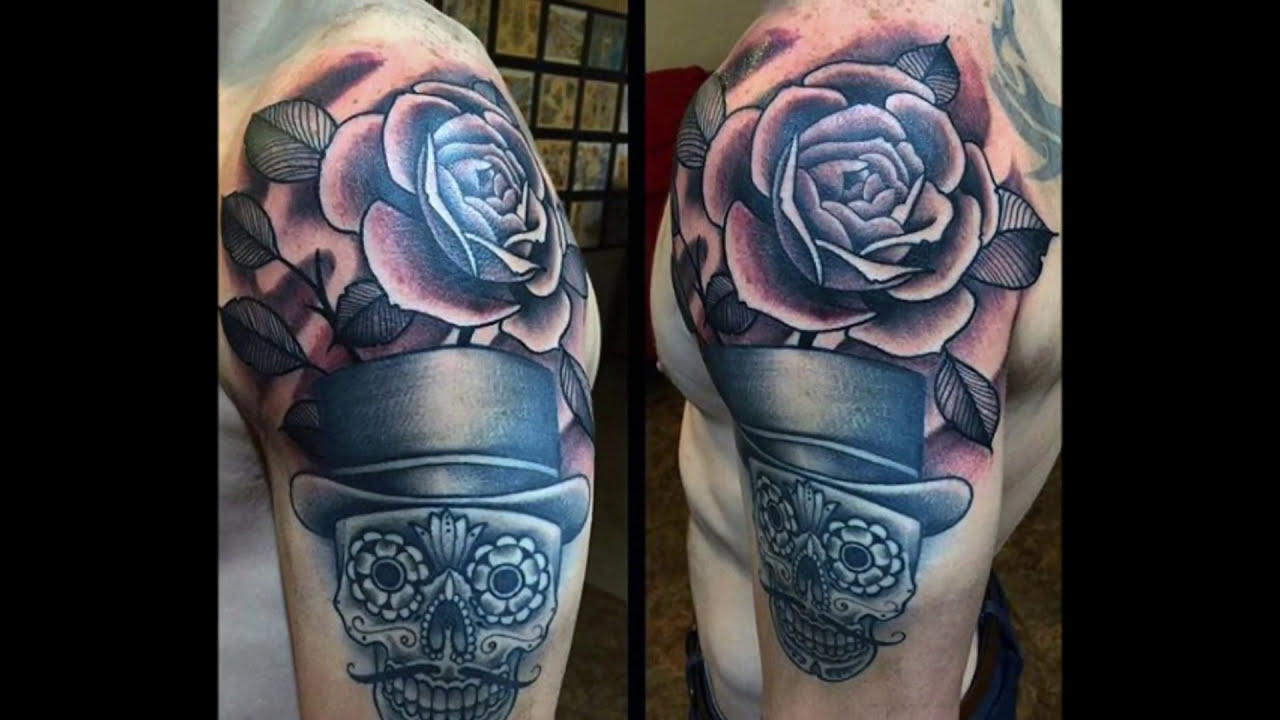
Moreover, sugar skull tattoos can convey various emotions and ideas. They symbolize the cycle of life and death, reminding us that mortality is an inevitable part of our existence. While they may appear macabre, these tattoos often carry a positive message, emphasizing the celebration of life and the belief in the spiritual journey beyond death. They encourage a perspective that embraces both the beauty and impermanence of life, urging individuals to live fully and cherish the present moment.
Furthermore, sugar skull tattoos can be seen as a rejection of societal norms and conformity. In a world where many people conform to certain ideals or expectations, these tattoos allow individuals to assert their individuality and express their uniqueness. Through the creative process of designing and choosing a sugar skull tattoo, individuals can explore and celebrate their own identity, values, and personal experiences.
The Meaning of Sugar Skull Tattoo Designs
Sugar skull tattoo designs boast an extensive range of artistic elements, each contributing to their captivating aesthetics. Let’s explore some of the key design aspects:
Vibrant Colors and Intricate Patterns
One cannot help but be drawn to the vivid colors and intricate patterns that adorn sugar skull tattoos. From vibrant reds and blues to rich purples and oranges, these tattoos burst with life and energy. The complex geometric patterns and delicate flourishes add depth and character to the overall design, making them visually stunning and absolutely captivating.
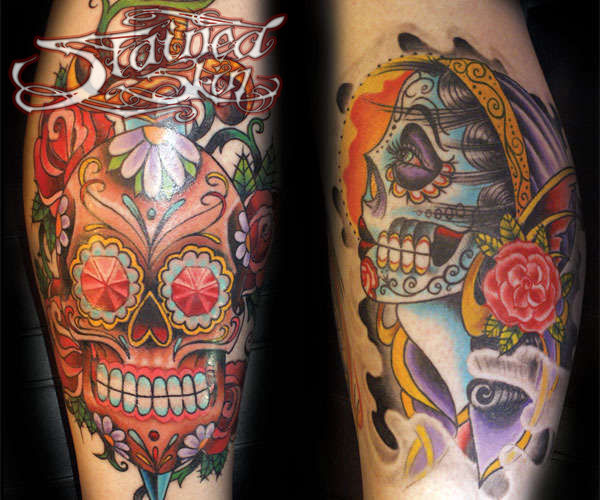
Floral Motifs and Symbolism
Flowers play a significant role in sugar skull tattoo designs, representing both beauty and fragility. Roses often symbolize love and passion, while marigolds are associated with the Day of the Dead celebrations, symbolizing remembrance. Incorporating these floral motifs adds a touch of elegance and further layers of symbolism to the overall tattoo design.
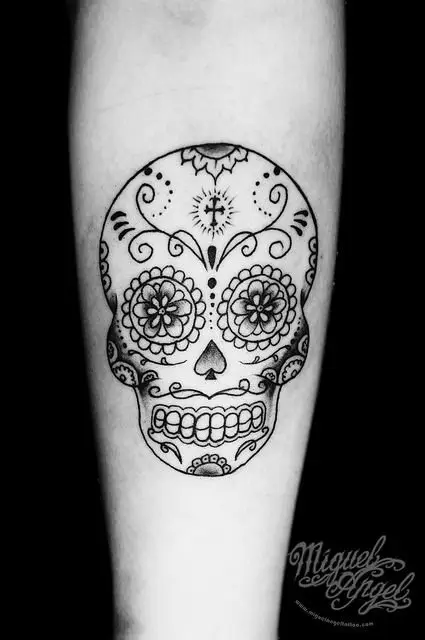
Elaborate Eye and Mouth Designs
The eyes and mouth of sugar skull tattoos are particularly striking, often accentuated with bold lines and striking details. These features represent the window to the soul and the ability to communicate beyond the boundaries of life and death. The elaborate eye and mouth designs embody the essence of connection and expression that transcends mortal existence.
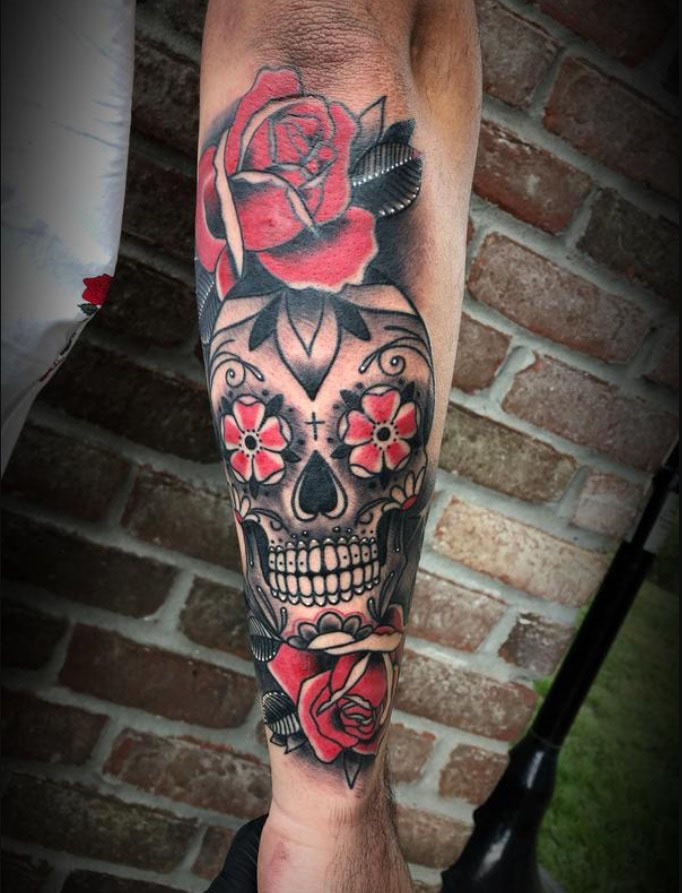
Personalized Symbols and Elements
Alongside the traditional sugar skull elements, individuals often incorporate personalized symbols or meaningful elements in their tattoos. These can range from significant dates, names, or objects that hold personal importance. By adding these personalized touches, individuals infuse their sugar skull tattoos with a deeper layer of significance, making them truly unique and personal.
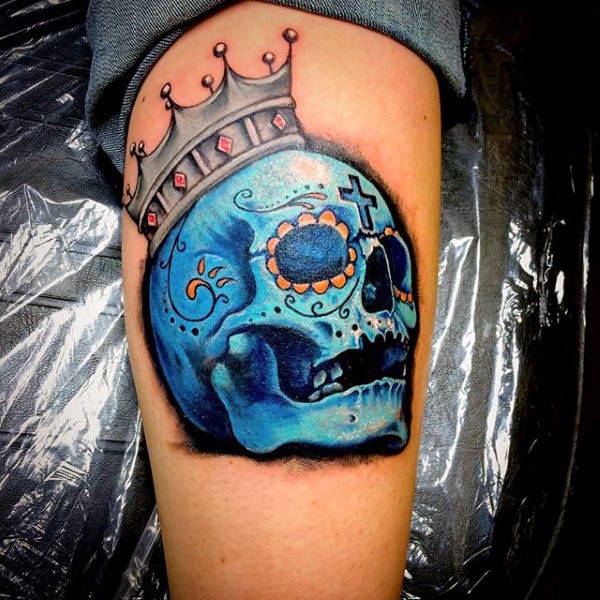
Conclusion: A Profound Expression of Art
Sugar skull tattoos are much more than just visually captivating designs. They hold deep cultural and symbolic meanings, representing life, death, remembrance, transformation, and personal identity. Through their vibrant colors, intricate patterns, and personalized elements, sugar skull tattoos offer individuals a means of self-expression while honoring their ancestors and celebrating the beauty of life’s cycles. So, if you’re considering getting a sugar skull tattoo, take the time to explore its rich symbolism and design intricacies, ensuring that your chosen design resonates with your own unique journey through existence.

I am Harvey Berry, a tattoo enthusiast who has immersed himself in the diverse world of ink, passionately exploring the beauty and artistry within each tattoo. My mission extends beyond uncovering the aesthetics of tattooing; it involves sharing in-depth knowledge across all aspects of this art form.
Fueled by genuine curiosity and love for every facet of tattooing, I have diligently crafted well-researched articles, with a special focus on the Tattoo Meaning of Impeccable Nest section. Here, my aim is to help the tattoo community gain a deeper understanding of the meanings and values embedded in each tattoo.
One of my primary goals is to encourage responsible decision-making when it comes to getting inked. I recognize that choosing to get a tattoo is a significant personal decision that requires careful consideration. Hence, I provide diverse resources covering the meaning of tattoos, the tattooing process, aftercare tips, and other valuable information.
Whether you are a seasoned tattoo enthusiast or embarking on your first exploration of the world of body art, I aspire to be a reliable resource for you at every step of your journey. I hope that my extensive knowledge of tattoos, especially in the Tattoo Meaning section, will assist you in finding inspiration to express yourself through the art of tattoos.
